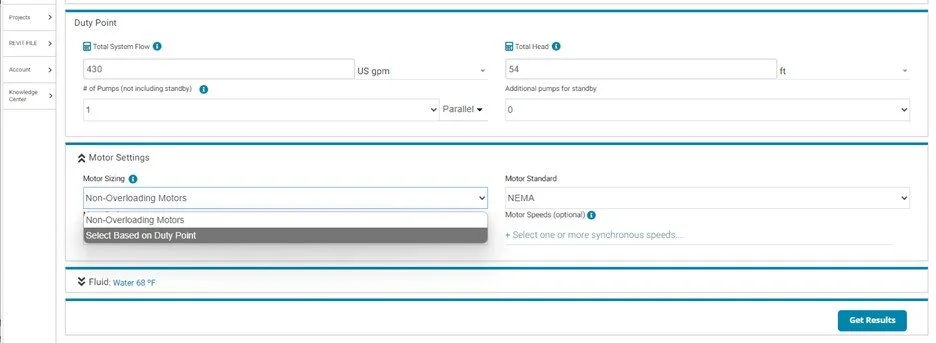How to Build a Centrifugal Pump Curve Part 3: Motor Selection
/By Mark Bingham
In Part 2 of our How to Build a Centrifugal Pump Curve series, we added five head/capacity curves to the e-1510 4BD pump curve we are building. These curves reflect the tested performance of pumps with various-size impellers. Now, it's time to focus on the pump’s power requirement and how it varies with impeller size and operating conditions.
Figure 1 is almost identical to the curve we left off with in Part 2. The only difference is that we’ve added the maximum power requirement for the pump.
Figure 1. Centrifugal pump curve with head/capacity curves for corresponding impeller sizes. Maximum power requirement for this pump is 20HP, as indicated in the upper right.
This straight line to the right of the 9.5-inch impeller curve tells us that the power requirement is less than 20 horsepower at any point on the five head/capacity curves shown. As the impeller diameter decreases, the power requirements also decrease. Manufacturers include a horsepower curve for each diameter impeller, as shown in Figure 2, to facilitate selection.
Figure 2. Straight diagonal lines indicate required horsepower based on duty point head and capacity, and impeller size. In this case, a 7.5 horsepower motor is required for duty point service. This is a suitable selection IF we are sure the pump will never exceed the duty point flow rate.
These horsepower curves show that the maximum power requirements for this pump vary between 7.5 and 20 horsepower, depending on impeller size. It is important to note that the horsepower curves only apply to water pumping—fluids with specific gravities greater than 1 (water) result in higher power requirements. The horsepower requirements will be reduced if the specific gravity is less than 1.
Overloading or Non-Overloading Motor?
When choosing a motor for a pump, we must determine if we need a non-overloading motor. A non-overloading motor can sufficiently power a pump over the entire range of its curve. If there is any question that the pump will exceed the duty point (i.e., design point), a non-overloading pump may be required.
Let’s say our duty point is 430 gpm at 54 feet of head. The curve in Figure 2 indicates that we can meet this duty point with an 8-inch impeller. The required power for this duty point is just under the 7.5-horsepower line. If we are confident the pump will never exceed the 430 gpm flow rate, we can use a 7.5-horsepower motor. However, if the flow exceeds 430 gpm, the motor will overload.
A non-overloading motor is the best choice if we can’t accurately predict the flow or whether a future condition may require additional flow. A 10-horsepower motor is only slightly more expensive than a 7.5-horsepower motor. While installation costs may increase due to the increased maximum electrical demand, the 10-horsepower motor is still more prudent. Larger heads and flows merit more careful consideration. A pump with a 100-horsepower motor is notably more expensive to buy and install than the same pump with a 75-horsepower motor.
Selection Software for Accuracy Beyond the Curve
As we’ve discussed in previous blogs, pump selection software, such as Systemwize, should be used to provide greater accuracy when determining a pump’s power requirement for the required conditions of service. This software allows us to select motors for the duty-point horsepower requirement or for non-overloading operation (Figure 3).
Figure 3. Systemwize selection software can be used to select pump motors for duty point or non-overloading service with greater accuracy.
The Systemwize output for 430 gpm at 54 feet of head is shown below (Figure 4). Although we’ve selected a motor at the duty point setting, the output indicates that the non-overloading (NOL) horsepower requirement for an 8-inch impeller is 8.71. Figure 2 above tells us we need a 10-horsepower motor to ensure non-overloading performance.
Figure 4. Systemwize helps finetune the pump motor requirement with greater accuracy than the head/capacity curves.
Remember—Fluid Types Impact Performance!
The selection software must also be used to determine power requirements (and impeller trim) when fluids other than water are used. In Figure 5, we have chosen a 50% ethylene glycol solution for our 430 gpm at 54 feet requirement.
Figure 5. It is important to specify the fluid you are pumping before selecting the motor. Power requirements vary depending on the specific gravity of the fluid.
Figure 6 shows the selection for 430 gpm at 54 feet when pumping a 50% ethylene glycol solution. Unlike our water example, the impeller diameter in this case remains unchanged, but the duty point horsepower has increased to 7.99 horsepower. This duty point requires a 10-horsepower motor. This motor is also non-overloading since the non-overloading horsepower for the 8-inch impeller is 9.3 horsepower.
Figure 6. This pump selection for a water/glycol solution is for the same head and capacity as our previous examples. Notice that the impeller size has not changed, but the duty point horsepower has increased from 7.49 (water) to 7.99 horsepower (water/glycol).
In the next blog, we’ll add efficiency islands to our curve and introduce an equation for calculating horsepower requirements.








